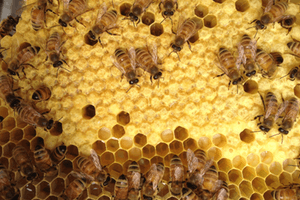- All-In-One Beekeeping for the Bees
- +1-608-728-8233
- info@beepods.com
3 Ways a Beepods Desiccant Will Help Your Bees Survive the Winter


Winter is a challenging time of year for beekeepers. Despite best efforts by even the most experienced beekeepers, cold conditions can be a colony’s doom. That’s why beekeepers must protect their hives from harsh winter elements. Today we’ll discuss how the Insulating Desiccant in Beepods’ Winterizing Kit helps your bees thrive in the cold. We’ll also give you tips for installing the desiccant as part of your hive winterizing process.
What is a Desiccant?
The desiccant included in our Winterizing Kit is a simple yet effective tool for keeping your bees safe and healthy through the winter. It’s a nylon case filled with wood shavings that protects your bees from three of the most dangerous threats they face during the winter: excess moisture, lack of ventilation, and extreme cold.
Managing Moisture Levels in the Hive
When your bees metabolize their hard-earned honey, they produce water vapor. The vapor condenses on the hive’s lid and creates a moist environment that’s unsafe for your bees in the winter with a cold + wet combo. It also makes the hive ripe for fungus and other organisms. No beekeeper wants to open their hive come spring and discover a moldy hive and dead bees!
That’s where the desiccant comes in. It wicks moisture from the hive and creates a more dry, comfortable, and fungus-free environment for your bees. The wood shavings and the nylon’s hygroscopic (moisture absorbing) nature make the desiccant ideal for managing moisture levels in the hive and preventing condensation. Your bees will appreciate not getting dripped on!
Maintaining Healthy Ventilation
If you’ve ever been in a house without a dehumidifier or air conditioning when it’s hot and humid out, you can understand first-hand why ventilation is essential in your bees’ home! When temperatures outside the hive drop to about 57 degrees Fahrenheit or lower, your bees generate heat by forming a cluster and shivering together over their brood. Clustering creates warm air that rises and combines with any moisture in the hive, perfect for growing pesky fungi and other organisms.
Ventilating your hive helps your bees maintain a healthy airflow, which reduces moisture build-up. Beepods’ desiccant does just the trick, not only absorbing moisture but allowing for ventilation without transferring cold air into the hive. The desiccant is placed at the top of the hive, between your top bar hive’s lid and its bars, positioned perfectly to move the warm, moist air rising inside. It’s like the perfect winter blanket for your hive – keeping it dry and warm, but not stuffy and humid!
Keeping Your Bees Warm with Insulation
Insulating your hive is a crucial step to your bees’ surviving the winter. With proper insulation, they don’t need to work as hard to heat the hive themselves. Bees can conserve their energy and efficiently use their winter food stores.
The nylon and wood shavings in our desiccant prevent hot air from escaping the hive and block cold winds while allowing the ventilation we talked about before. The desiccant’s nylon case adequately covers the bars of your top bar hive, providing a blanket of insulation that will keep your bees nice and cozy inside. After you’ve placed the desiccant in your hive and close the lid, you can rest assured your bees will be comfortable despite the cold.

Here is the insulating desiccant with its woodchips distributed as suggested.
How to Install the Insulating Desiccant
With your Beepod lid open, place the desiccant pillowcase over the top bars, with the wood shavings evenly distributed inside. Pro tip: It’s okay if the pillowcase “waterfalls” over the edge of the bars. Adjust the wood shavings to allow room for the lid’s inside ribs to touch down.
Next, you’ll distribute the shavings so there is a bigger lump, about 9 inches across, in the middle. On each side, there should be smaller lumps about 4 inches across. From there, adjust the shavings until you can lock the lid of your Beepod or top bar hive. For a visual tutorial on installing the desiccant, check out our members’ access area, Beepods Lab.
Conclusion
No beekeeper wants to lose their bees to harsh winter conditions. The desiccant in Beepods’ Winterizing Kit keeps your hive stay dry, ventilated, and insulated. This allows your bees to focus on staying warm and nourishing themselves through the season. Knowing your bees are safe and comfortable in the hive will let you rest assured you’re doing everything you can to help them thrive.
Protect Your Bees from Other Winter Hazards!
Our Beepods System Winterizing Kit has you covered, with tools to protect your bees from mice and small critters, manage conditions in the hive, and keep out the cold.
Kanoe Riedel
Latest posts by Kanoe Riedel (see all)
- This Spring, Don’t Forget Why Bees Are So Important to Our Environment - March 26, 2021
- 11 Awesome Uses for Your Stored Honeycomb - March 2, 2021
- How the Right Beekeeping Equipment Makes Inspections Better for Beekeepers and Bees - February 12, 2021



